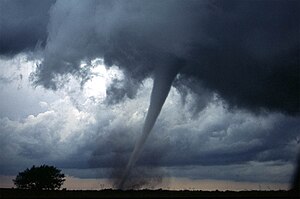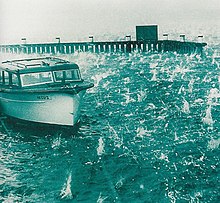Portal:Tornadoes
Note: Tornadoes are very dangerous and potentially deadly. Always take tornado warnings seriously and immediately seek shelter. |
The Tornadoes Portal

Selected tornado article -
The 1947 Sydney hailstorm was a natural disaster which struck Sydney, Australia, on 1 January 1947. The storm cell developed on the morning of New Year's Day, a public holiday in Australia, over the Blue Mountains, hitting the city and dissipating east of Bondi in the mid-afternoon. At the time, it was the most severe storm to strike the city since recorded observations began in 1792.
The high humidity, temperatures and weather patterns of Sydney increased the strength of the storm. The cost of damages from the storm were, at the time, approximately £750,000 (US$3 million); this is the equivalent of around A$45 million in modern figures. The supercell dropped hailstones larger than 8 centimetres (3.1 in) in diameter, with the most significant damage occurring in the central business district and eastern suburbs of Sydney. (Full article...)
Selected tornado list -
This list of Alabama tornado events includes notable storms which affected the US state of Alabama. Because it is not always simple to determine if damage was caused by multiple tornadoes or by a single tornado moving across an area, then the list includes the overall tornado events. Several events also affected other U.S. states.
The following is a partial list, by month and year:
- February 1884: Enigma tornado outbreak (10 counties)
- March 1920: 1920 Palm Sunday tornado outbreak (4 counties)
- May 1929: 1929 Rye Cove, Virginia tornado outbreak
- March 1932: 1932 Deep South tornado outbreak
- April 1936: 1936 Tupelo–Gainesville tornado outbreak
- April 1956: April 1956 Birmingham tornado
- April 1957: April 1957 Southeastern United States tornado outbreak
- 1974: 1974 Super Outbreak
- January 1975: Great Storm of 1975
- April 1977: April 1977 Birmingham tornado
- November 1989: November 1989 tornado outbreak (Huntsville)
- November 1992: November 1992 tornado outbreak
- March 1994: 1994 Palm Sunday tornado outbreak (8 counties)
- May 1995: May 1995 Tornado Outbreak Sequence (Huntsville)
- April 1998: April 1998 Birmingham tornado
- December 2000: December 2000 Tuscaloosa tornado
- November 2001: Arkansas–Mississippi–Alabama tornado outbreak
- November 2002: 2002 Veterans Day Weekend tornado outbreak
- August 2005: Hurricane Katrina tornado outbreak
- November 2005: Late-November 2005 tornado outbreak
- September 2006: Late-September 2006 tornado outbreak
- November 2006: Mid-November 2006 tornado outbreak
- March 2007: February–March 2007 tornado outbreak
- January 2008: January 2008 tornado outbreak sequence
- February 2008: 2008 Super Tuesday tornado outbreak
- April 2009: April 2009 tornado outbreak
- April 2010: Tornado outbreak of April 22–25, 2010
- April 2011: 2011 Super Outbreak (19 counties)
- December 2012: Late December 2012 North American storm complex (14 counties)
- March 2019: Tornado outbreak of March 3, 2019 (Full article...)
Selected image -

Selected tornado year -
This page documents the tornadoes and tornado outbreaks of 1953, primarily in the United States. Most tornadoes form in the U.S., although some events may take place internationally. Tornado statistics for older years like this often appear significantly lower than modern years due to fewer reports or confirmed tornadoes. This was the first year to record an F5 tornado as well as one of the deadliest tornado seasons in official U.S. records, which go back to 1950.
The total count of tornadoes and ratings differs from various agencies accordingly. The article, therefore, documents information from the most contemporary official sources alongside assessments from tornado historian Thomas P. Grazulis. (Full article...)
Related portals
2024 tornado activity
This page documents all tornadoes confirmed by the European Severe Storms Laboratory or various governments or universities across Europe during 2024. Unlike the United States, the original Fujita Scale and the TORRO scale are used to rank tornadoes across the continent.
According to the European Severe Storms Laboratory, there have been 814 confirmed tornadoes in Europe in 2024 (to date October 4th), resulting in 13 injuries. (Full article...)
List of 2024 tornado articles
|
|---|
Tornado anniversaries
November 20
- 1900 – A major tornado outbreak killed at least 77 people across the Southeastern United States. A long-lived family of tornadoes, the strongest of which was rated F4, killed at least 30 people in Mississippi and Tennessee, including 11 near Strayhorn, Mississippi and 15 on plantations in Tunica County, Mississippi. Another F4 tornado devastated the west side of Columbia, Tennessee, killing 27 people.
November 21
- 1883 – A tornado outbreak affected parts of Arkansas and Missouri between midnight and dawn. An F3 tornado hit Melbourne and LaCrosse, Arkansas, killing seven people; two in one family in LaCross and five in another house in Melbourne. The funnel, described as "a huge rolling ball of fire," was visible up to 7 miles (11 km) away due to frequent lightning. Three others were killed by tornadoes near Charleston, Charleston, and Pocahontas, Arkansas and two more near Bertrand, Missouri.
- 1992 – A major tornado outbreak affected the Southeastern United States and Ohio Valley. A late-night F4 tornado, which continued past midnight, tracked 128 miles (206 km) across southern and central Mississippi, killing 12 people and injuring 122. Ten of the deaths and 98 injuries were in and around Florence, and Brandon, where an entire subdivision was leveled. Strong tornadoes continued into the next day and following night, resulting in a total of 26 deaths and 638 injures. Damage from the tornadoes totaled $712 million.
November 22
- 1874 – An F4 tornado damaged or destroyed about a third of Tuscumbia, Alabama, killing 12 people in town and at least 2 others in nearby rural areas. An F3 tornado damaged or destroyed about half the buildings in Montevallo, Alabama, killing two others.
Did you know…
- ...that the 2013 Moore tornado that struck Moore and Newcastle, Oklahoma, is the most recent EF5 tornado?
- ...that the 2021 South Moravia tornado, an IF4 tornado with winds between 207–260 mph (333–418 km/h), was the strongest tornado to hit the Czech Republic in modern history?
General images -
The 1999 Sydney hailstorm was the costliest natural disaster in Australian insurance history, causing extensive damage along the east coast of New South Wales. The storm developed south of Sydney on the afternoon of Wednesday, 14 April 1999, and struck the city's eastern suburbs, including the central business district, later that evening.
The storm dropped an estimated 500,000 tonnes of hailstones in its path. The insured damage bill caused by the storm was over A$1.7 billion (equivalent to $3.8 billion in 2022), with the total bill (including uninsured damage) estimated to be around $2.3 billion. It was the costliest single natural disaster in Australian history in insured damage, surpassing the $1.1 billion in insured damage caused by the 1989 Newcastle earthquake. Lightning also claimed one life during the storm, and the event caused approximately 50 injuries. (Full article...)
Topics
Subcategories
Related WikiProjects
The scope of WikiProject Severe weather is to write articles about severe weather, namely thunderstorms and tornadoes. Their talk page is located here.
WikiProject Weather is the main hub for all articles that are weather-related. WikiProject Weather strives to improve articles in a variety of weather topics, including Tropical Cyclones, Severe Weather, General meteorology, Non-tropical Storms, Climate, Floods, Droughts and wildfires, Meteorological instruments and data, Meteorological Biographies, and Space Weather. If you would like to help, please visit the project talk page.
WikiProject Meteorology is a collaborative effort by dozens of Wikipedians to improve the quality of meteorology- and weather-related articles. If you would like to help, visit the project talk page, and see what needs doing. The project is currently being merged into WikiProject Weather.
WikiProject Tropical cyclones is a daughter project of WikiProject meteorology. The dozens of semi-active members and several full-time members focus on improving Wikipedia's coverage of tropical cyclones.
Wikipedia is a fully collaborative effort by volunteers. So if you see something you think you can improve, be bold and get to editing! We appreciate any help you can provide!
Things you can do
Wikimedia
The following Wikimedia Foundation sister projects provide more on this subject:
-
Commons
Free media repository -
Wikibooks
Free textbooks and manuals -
Wikidata
Free knowledge base -
Wikinews
Free-content news -
Wikiquote
Collection of quotations -
Wikisource
Free-content library -
Wikiversity
Free learning tools -
Wikivoyage
Free travel guide -
Wiktionary
Dictionary and thesaurus









































